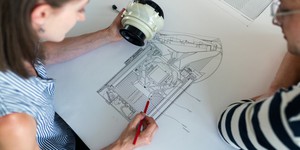Log In
Summary
*Note:
For this science project you will need to develop your own experimental procedure. Use the information in the summary tab as a starting place. If you would like to discuss your ideas or need help troubleshooting, use the Ask An Expert forum. Our Experts won't do the work for you, but they will make suggestions and offer guidance if you come to them with specific questions.
If you want a Project Idea with full instructions, please pick one without an asterisk (*) at the end of the title.
If you want a Project Idea with full instructions, please pick one without an asterisk (*) at the end of the title.
Abstract
How much force is required to advance a lag bolt (large wood screw with a hex-shaped head) into a piece of wood? You can measure the force by using a spring scale attached to the handle of ratchet. Pull on the spring scale until the bolt starts to turn, and note the required force from the spring scale. There are many potential experiments you could try. Think about answering the following questions: How does the force change as the bolt advances deeper into the wood? Why? How does the required force change as the diameter of the pilot hole is changed? Why? Can you change the required force by rubbing the bolt's threads with soap or wax? (Coyle, 2005)Bibliography
Coyle, C.P., 2005. "Some Variables Affecting the Torque Required to Turn a Screw," California State Science Fair Project Abstract [accessed April 18, 2006] http://cssf.usc.edu/History/2005/Projects/J0205.pdf.Ask an Expert
Do you have specific questions about your science project? Our team of volunteer scientists can help. Our Experts won't do the work for you, but they will make suggestions, offer guidance, and help you troubleshoot.
Global Connections
The United Nations Sustainable Development Goals (UNSDGs) are a blueprint to achieve a better and more sustainable future for all.
This project explores topics key to Industry, Innovation and Infrastructure: Build resilient infrastructure, promote sustainable industrialization and foster innovation.
Careers
If you like this project, you might enjoy exploring these related careers:
Career Profile
Have you ever seen an assembly line in a factory on TV? Or have you ever gone on a factory tour? Did you notice all of the conveyor belts and machines working so quickly together? Advanced manufacturing technicians make sure all of these machines keep running. They maintain and repair the electrical and mechanical parts of these machines. They know how fluid systems, like pumps, and gas systems work. Gas systems use compressed air to power machines to clamp, stack, and move items. Technicians…
Read more
Career Profile
Mechanical engineers are part of your everyday life, designing the spoon you used to eat your breakfast, your breakfast's packaging, the flip-top cap on your toothpaste tube, the zipper on your jacket, the car, bike, or bus you took to school, the chair you sat in, the door handle you grasped and the hinges it opened on, and the ballpoint pen you used to take your test. Virtually every object that you see around you has passed through the hands of a mechanical engineer. Consequently, their…
Read more
Career Profile
You use mechanical devices every day—to zip and snap your clothing, open doors, refrigerate and cook your food, get clean water, heat your home, play music, surf the Internet, travel around, and even to brush your teeth. Virtually every object that you see around has been mechanically engineered or designed at some point, requiring the skills of mechanical engineering technicians to create drawings of the product, or to build and test models of the product to find the best design.
Read more
Career Profile
Physicists have a big goal in mind—to understand the nature of the entire universe and everything in it! To reach that goal, they observe and measure natural events seen on Earth and in the universe, and then develop theories, using mathematics, to explain why those phenomena occur. Physicists take on the challenge of explaining events that happen on the grandest scale imaginable to those that happen at the level of the smallest atomic particles. Their theories are then applied to…
Read more
Related Links
Cite This Page
General citation information is provided here. Be sure to check the formatting, including capitalization, for the method you are using and update your citation, as needed.MLA Style
Science Buddies Staff.
"The Turn of the Screw." Science Buddies,
7 May 2021,
https://www.sciencebuddies.org/science-fair-projects/project-ideas/ApMech_p032/mechanical-engineering/turn-of-the-screw?class=AQW0SbgRd4KI_yiijOMUC6MDKL-yyR2pGA3BmJYNFpydKRIGdhNt1QHQIUKWw7B2zddBy5_Xv0cC5NmDmyZSoQPbQO7sK7oOJi47Hru9LgAQ9w.
Accessed 25 Apr. 2024.
APA Style
Science Buddies Staff.
(2021, May 7).
The Turn of the Screw.
Retrieved from
https://www.sciencebuddies.org/science-fair-projects/project-ideas/ApMech_p032/mechanical-engineering/turn-of-the-screw?class=AQW0SbgRd4KI_yiijOMUC6MDKL-yyR2pGA3BmJYNFpydKRIGdhNt1QHQIUKWw7B2zddBy5_Xv0cC5NmDmyZSoQPbQO7sK7oOJi47Hru9LgAQ9w
Last edit date: 2021-05-07
Explore Our Science Videos
Explore Enzyme Activity!
Solar Panel Angle for the Junior Solar Sprint
Two-Stage Balloon Rocket Introduction











